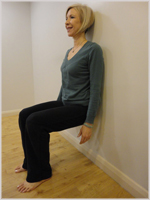Gina John has worked in exercise and rehabilitation for over 20 years. A Pilates Practitioner and Registered Osteopath, she founded The Osprey Clinic, which specialises in exercise and rehabilitation programmes, for the over 50s and individuals requiring tailored fitness and rehabilitation.
Gina is pleased to offer Silver Travel Advisor customers help and advice with a quarterly column, looking at how to prepare for travel and how to stay fit and mobile, while away from home. Also, Gina offers tips on how to deal with aches and pains while travelling, including a focus on seasonal travel problems.
The snow forecast in Europe is encouraging this winter, but unless you’ve been working hard at the gym in preparation for alpine pursuits, you may be concerned about how you will endure the long hours on the slopes or on the cross-country route this year.
Winter sports rely heavily on the powerful limb muscles, but our core stability or postural muscles are also important. Our postural muscles work at around 25-30% of maximum contraction while we are sitting or standing straight. We contract muscles around the hips, abdomen, pelvic floor, spinal column and shoulders to maintain this erect posture and adopting the requisite ski positions.
Our postural muscles start to fatigue with extended periods of sitting, standing, walking and skiing, and the body makes compensations to be able to continue our activities. This includes poking the chin forwards, arching or curving the low back or rounding the shoulders. So, it’s not surprising that aches and pains in these areas are common.
Posture is the most important determinant of the efficient functioning of the limb muscles and tendons, enabling them to maintain their correct length and operate efficiently. While skiing, the compensations made by the body for weak postural muscles, results in overworking the hip girdle muscles, so it’s common for the buttock and the front of the thighs to feel sore until your body has time to adapt to the skiing posture. However, we may be scheduled on the return flight before the body has time to adjust, unless we get fit for the sport ahead of our holiday!
The following daily programme of postural exercises will help to improve your postural muscles so as to get the most out of your ski holiday.
Diamond press
 Start by placing your hands beneath your forehead with your elbows pointing out to the sides.
Start by placing your hands beneath your forehead with your elbows pointing out to the sides.Draw back your abdominal muscles firmly, by scooping in the navel towards the spine.
Exhale as you lift your head from your hands, while trying to squeeze your shoulder blades towards the back of your waist. Inhale to hold the lifted position and exhale as you lower your forehead back to your hand again.
Repeat up to 15 times.
Wall slide

Stand about 1 foot away from the wall with your back pressed against it.
Draw back your abdominal muscles firmly, by scooping in the navel towards the spine and slide down the wall so that your knees are bent at 90 degrees, or as far as comfortable.
Hold the position for 3-5 breaths then slide back up the wall, by straightening your legs again.
Repeat up to 10 times.
Lunges

Take the right leg behind you far enough, so that you can bend the left knee to about 90 degrees, or as far as is comfortable, while keeping the left foot in contact with the
floor.
Keep the toes on the right foot curled under, so that the weight is on the ball of the foot.
Keep your abdominal muscles firmly scooped in, drawing in the navel towards the spine while you repeatedly bend and stretch the left knee, up to 15 times.
Then, repeat on the other side.












